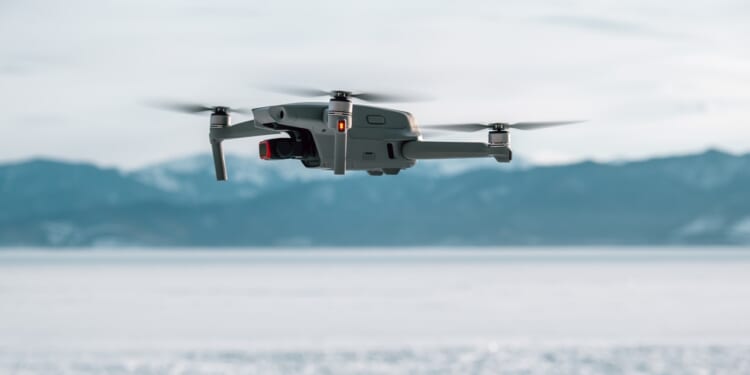High in the mountains of the Tibetan Plateau, there is thin air, low pressure, and violent winds—the ideal crucible for developing sturdy all-weather drones.
China is seeking to dominate all aspects of the new revolution in military affairs—driven in large part by the ongoing “Fourth Industrial Revolution” in the global civilian economy. In practical terms, this means that Beijing’s military scientists are pursuing weapons that are increasingly automated, redundant, cheap, and versatile.
As evidenced by the ongoing Ukraine War, drones of all kinds are the tactical linchpin to fighting and winning today’s and tomorrow’s wars. Enter China’s new “Ali Yundun-1” drone testing center, inaugurated in Ngari Prefecture in western Tibet.
What to Know About China’s New Drone Facility
Situated high above the region in the mountains of Tibet, Beijing chose this location for its new drone testing facility for its technical challenge, symbolism, and latent strategic value. From an engineering perspective, the decision to base a large drone testing facility roughly 15,000 feet above sea level in the Tibetan mountains is a logical decision. It ensures that military drones of the kind that China is developing will work under the stress of high-intensity, modern combat, and China must test these prototypes in the most extreme conditions imaginable. Up high in the mountains of the Tibetan Plateau, there is thin air, low pressure, and violent winds—the ideal crucible for developing sturdy all-weather drones.
China’s state-run media asserts that the facility will be part of their massive civil-military fusion. Not only will the People’s Liberation Army (PLA) develop (and test) unmanned military systems at this new facility, but civilian systems will be tested there, too. The facility’s drones could be involved in mountain rescue, tourism, inspection, and logistics for civilian purposes. But a deeper reading suggests that Beijing is stacking the deck for advantage in its contested border regions—where control of altitude, endurance, and sensor reach becomes a significant advantage.
According to The Defence Post, the “Ali Yundun-1” high-altitude drone facility’s primary purpose is to give the PLA, and Chinese intelligence, a high-tech advantage near China’s contested border with India.
A “Low-Altitude Economy” or a High-Powered Military Capability?
Behind the scenes, Chinese technocrats are aligning with universities, local governments, and labs to cultivate an indigenous ecosystem—very near those contentious, mountainous borders with rising India—of optimized components, talent pipelines, and a “low-altitude economy,” as Yuan Jianping, an expert on the UN Sustainable Development Goals and a former vice-president of China’s Northwestern Polytechnical University in Shanxi, described it. The same systems employed for a “low-altitude economy,” however, can also be used for military intelligence, surveillance, reconnaissance (ISR) missions. As the war in Ukraine has illustrated so clearly, civilian economic drones carrying cameras or supplies can be easily turned into military drones carrying weapons.
In 2020, the brief Sino-Indian war over control of the roof of the world ended in a stalemate that largely favored India. The Indian forces that had been stationed in that mountainous region were conditioned to fight in that unique environment. What’s more, those Indian troops were better equipped than their Chinese counterparts. They employed systems—and tactics—better suited for high-altitude combat. China’s inability to confront the Indians on its terms ultimately forced it into a more conciliatory stance. But the conflict was merely frozen. No part of the underlying territorial dispute was resolved.
And should China exercise greater—and more technological—control over the region adjacent to the disputed sector with India, the Chinese PLA could refine a superior way of war in those high-altitude areas.
For instance, China could refine power systems, de-icing procedures, and sensors better attenuated for that difficult and dangerous part of the world, and enhance the autonomous features of drones operating there at a faster rate than the Indians who are arrayed against Chinese interlopers just across the mountainous borders.
What Would Chinese Superiority in the Himalayas Mean?
During the India-Pakistan War that erupted in May of this year, China was the key military supplier for Pakistan’s Armed Forces. Beijing essentially used that conflict as a cheap way to test its PL-15 air-to-air missiles, as well as several warplanes—all of which performed better than expected in the hands of seasoned Pakistani Air Force fighter pilots against the nominally superior US-backed Indian Air Force.
By placing this experimental drone facility in the high mountains of the Tibetan Plateau region—a facility that will ultimately streamline and advance China’s already meteoric drone production—Beijing is converting Tibet from a political periphery to a central node in its unmanned warfare revolution.
Testing at this elevation gives Beijing’s forces a real-world laboratory for drones that might operate in the Himalayan fringes, over contested border areas, or in mountain corridors.
Converting Tibet into a high-end drone testing lab likewise sends the unmissable message to the region—and the United States—that China is a master of extremes. It controls the high ground. Further, China’s forces are consolidating its dominance in this difficult theater of operations that could stymie Indian security measures that have thus far contained Chinese territorial ambitions there.
With this new facility, China is turning thin air into a strategic dimension. Beijing is seeking to turn one of Earth’s most punishing environments into a testing ground for its most advanced weapons—as well as a force multiplier to ensure regional dominance over India.
This all comes at a time when Beijing seeks to exert greater control over its periphery, not just in the so-called First Island Chain but in Central and South Asia as well. China desires to extend its influence and control into the Indian Ocean as well—and this new drone facility is part of that long-term effort.
About the Author: Brandon J. Weichert
Brandon J. Weichert is a senior national security editor at The National Interest. Recently, Weichert became the host of The National Security Hour on America Outloud News and iHeartRadio, where he discusses national security policy every Wednesday at 8pm Eastern. He is also a contributor at Popular Mechanics and has consulted regularly with various government institutions and private organizations on geopolitical issues. Weichert’s writings have appeared in multiple publications, including The Washington Times, National Review, The American Spectator, MSN, The Asia Times, and others. His books include Winning Space: How America Remains a Superpower, Biohacked: China’s Race to Control Life, and The Shadow War: Iran’s Quest for Supremacy. His newest book, A Disaster of Our Own Making: How the West Lost Ukraine is available for purchase wherever books are sold. He can be followed via Twitter @WeTheBrandon.
Image: Shutterstock / lunikka.


















